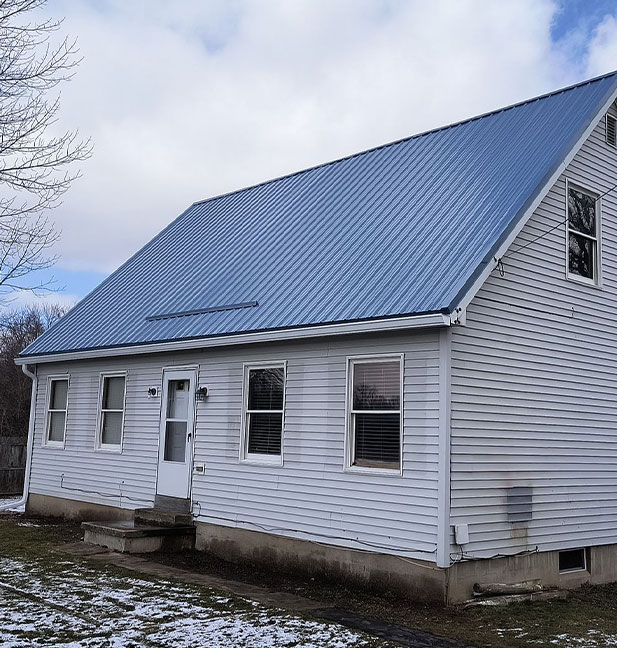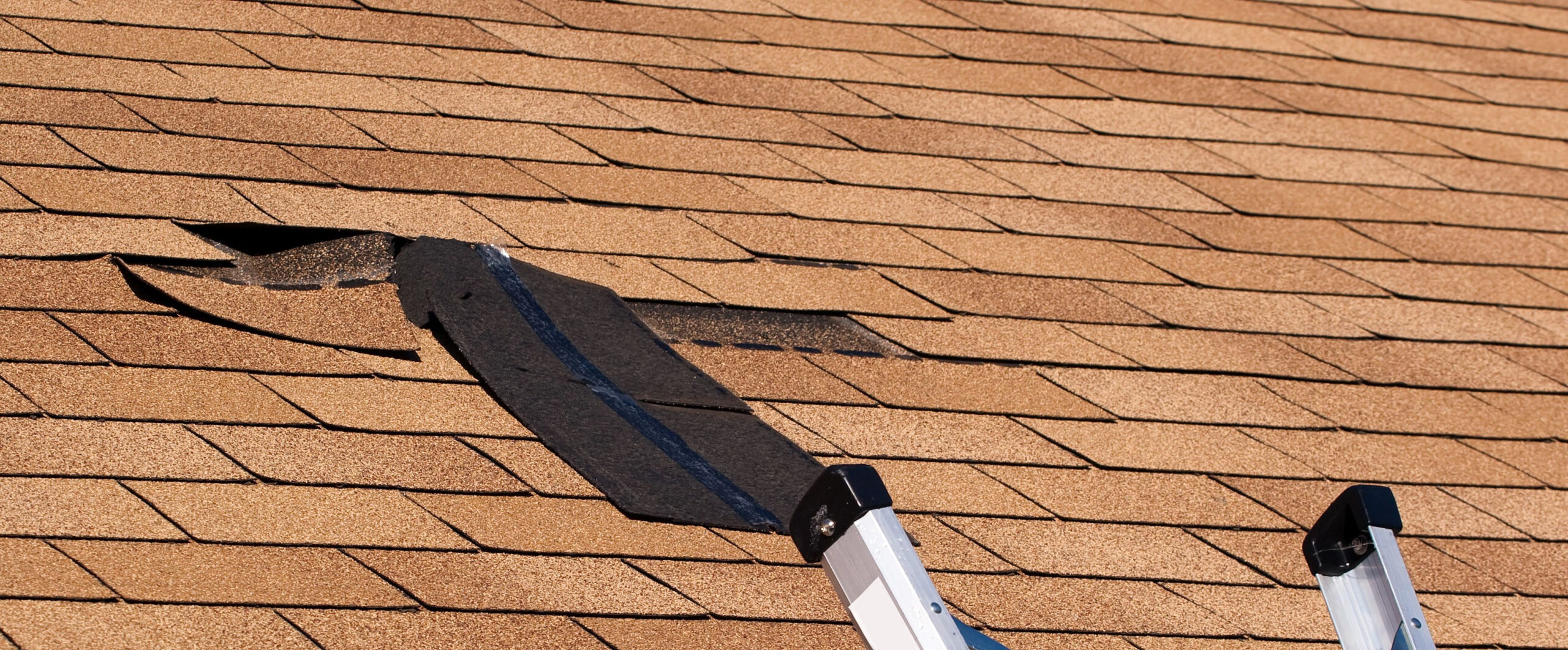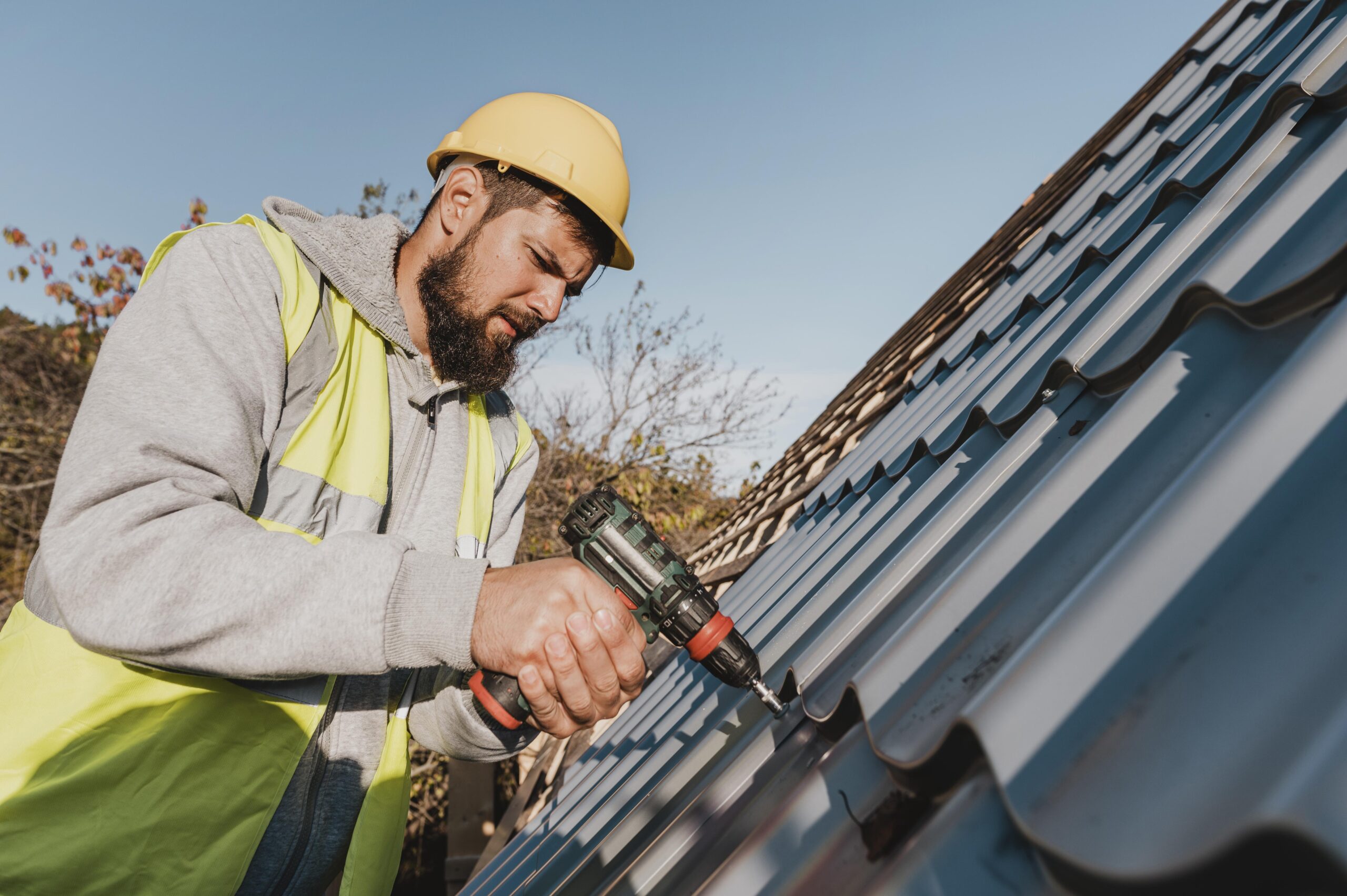Indicators You Required Roof Repair: Shield Your Financial Investment With These Easy Checks
Understanding the indications that show a demand for roofing system repair work is crucial for guarding your residential or commercial property and financial investment. Usual signs such as missing shingles, unexpected water stains, and granules gathering in seamless gutters can recommend underlying problems that, if left unaddressed, might intensify into even more serious issues. Furthermore, signs like drooping areas or increased power expenses can likewise indicate ineffectiveness or damage. To guarantee your roofing system continues to be in leading condition and to stay clear of pricey repair services, it is important to identify these very early caution signs and act as necessary. What actions should you take next?
Missing Out On or Damaged Shingles
When examining the condition of your roofing, one of the most telling indicators of prospective concerns is the presence of missing or harmed shingles. Roofing shingles function as the first line of protection versus the elements, and their stability is important for preserving the total health and wellness of your roof covering system - I&E Roofing & Construction, Inc.. A couple of missing out on roof shingles may appear minor, but they can lead to substantial water infiltration, compromising the underlying framework and demanding a lot more comprehensive repairs
Harmed tiles can manifest in numerous methods, including curling, cracking, or blistering. Each of these conditions can decrease the efficiency of your roof, permitting moisture to penetrate and bring about a lot more extreme problems. Roofing Service. It is important to perform regular examinations, specifically after serious weather events, as high winds and heavy rainfall can intensify shingle damage
If you identify missing or harmed roof shingles, it is recommended to attend to these issues quickly. While minor repairs may be workable for a property owner, extensive damage usually warrants professional intervention. Prompt activity can protect against further problems and guard your financial investment, making sure the durability and efficiency of your roofing.
Water Discolorations on Ceilings
Water stains on ceilings are often clear indicators of underlying water damage that needs immediate interest. Determining the source of these stains is vital, as they can result from various issues, including roofing leaks or plumbing troubles. Addressing the source not just protects against additional damage however likewise safeguards the honesty of the home.
Identifying Water Damage

When evaluating for water stains, take note of both the dimension and form of the discoloration. Uneven forms might suggest recurring leaks, while a lot more specified locations can suggest previous concerns. Additionally, think about the area of the stains; stains near plumbing fixtures or outside walls may supply ideas concerning prospective sources of the water breach.
It is also important to analyze the structure of the ceiling surrounding the stains. Peeling off paint or gurgling drywall can indicate substantial wetness direct exposure, requiring prompt focus. Regular evaluations and timely action can aid protect against extra extreme water damages, safeguarding both the structural integrity of the home and the financial investment it represents. Constantly consult an expert for a detailed analysis if you find water spots on your ceilings.
Causes of Discolorations
What variables add to the appearance of stains on ceilings? Water stains, commonly showing up as stained patches, are mainly triggered by leaks in the roofing system or pipes systems - I&E Roofing & Construction, Inc.. When wetness penetrates with roof materials or endangered pipes, it can accumulate and lead to visible staining on ceilings
One usual reason is damaged or missing out on roof shingles, which can permit rainwater to permeate into the attic room and, eventually, to the ceilings listed below. Furthermore, incorrect flashing around smokeshafts, vents, or skylights can be a considerable resource of water intrusion. Plumbing leakages, whether from faulty pipes or overflowing fixtures, can additionally produce spots, particularly in locations straight below shower rooms or cooking areas.

Recognizing the resource of the tarnish is vital for efficient fixing. Neglecting these signs can bring about a lot more considerable damage, including mold and mildew growth and structural weakening, underscoring the significance of prompt treatment to secure your financial investment.
Granules in Rain gutters
During regular inspections of your seamless gutters, the visibility of granules can be a substantial sign of roofing damage. These small, sand-like particles are commonly located externally of asphalt shingles, working as a safety layer against UV rays and weathering. Over time, wear and tear can cause these granules to dislodge, causing a range of concerns that might jeopardize the integrity of your roofing system.
If you discover a buildup of granules in your seamless gutters, it is important to take this indicator seriously. The loss of granules may subject the underlying asphalt to the components, boosting the risk of leakages and water damages. This scenario not only endangers your roof's life-span but can likewise lead to expensive repairs otherwise resolved without delay.
To alleviate prospective damages, it is advisable to inspect your roofing system frequently, especially after serious weather condition events. Additionally, engaging a specialist roofer to assess the condition of your tiles can provide important insights. Early intervention is vital to protecting your investment and making sure the long life of your roof covering system. Remember, granules in seamless gutters are not an unimportant concern; they indicate the requirement for instant attention and potential repair.

Sagging Roof Covering Areas
Sagging roof areas can indicate serious architectural concerns that call for immediate focus (Roofing Service). Noticeable defects on the roof covering's surface area, incorporated with the presence of water discolorations inside the home, are crucial indication that need to not be neglected. Attending to these problems without delay can stop further damage and costly repairs
Noticeable Roofing Deformities
How can homeowners recognize possible problems with their roofs? Among the most telling indications is visible roof covering deformities, specifically sagging locations. A sagging roofing may look like dips or curves, showing underlying architectural issues that might endanger the stability of the whole roof system. Property owners ought to carry out routine inspections, seeking any kind of visible irregularities in the roofline.
Numerous variables can contribute to noticeable defects, including water damage, inappropriate setup, or the weight of accumulated snow and particles. If a roofing system shows up to sag, it may suggest damaged rafters or trusses, which can lead to more extreme issues if left unaddressed. A drooping roof not just threatens the structural stability of the home however can also cause expensive fixing bills if the problem escalates.
If drooping or various other noticeable deformities are observed, it is suggested to seek advice from a specialist professional roofer. They can examine the scenario, identify the reason for the sagging, and advise ideal repair service options. Timely treatment is necessary to shield your financial investment and assure the longevity of your roofing.

Water Spots Inside Home
The presence of water spots inside the home commonly signifies possible problems with the roof, specifically in locations where sagging has actually been observed. These stains typically suggest that water is penetrating through the roof covering material, which can bring about considerable architectural damage if left unaddressed. Sagging roofing system areas might be brought on by a variety of aspects, consisting of insufficient support, collected moisture, or the degeneration of roofing materials.
When you see water spots, it is essential to examine the resource of the dampness. Try to find indicators of drooping in the roofing system framework, as this can aggravate the problem. Usually, sagging locations can trap water, causing leaks and further damages. Additionally, it is essential to review the age of the roofing; older roofs are more vulnerable to deterioration, boosting the probability of leakages.
Trigger action is necessary to reduce damages. Consult a qualified roof professional to analyze the situation and advise ideal repairs. Overlooking water spots and drooping can cause pricey repairs and compromise the integrity of your home. Safeguard your investment by dealing with these signs before they escalate right into extra extreme issues.
Boosted Energy Bills
An unanticipated spike in energy bills can typically indicate underlying problems with your roofing system. When your roof covering is compromised, it can result in considerable air leakages, allowing conditioned air to leave and unconditioned air to penetrate your home. This inefficiency forces your heating and cooling down systems to work harder, resulting in raised power intake and higher energy prices.
One common wrongdoer is harmed or missing tiles, which can subject your home's interior to the elements. Additionally, poor insulation because of roof damages can add to power loss. If you discover a constant rise in your energy costs without a corresponding modification in use practices, it is vital to check out potential roof-related concerns.
Regular roof covering examinations are important for recognizing problems prior to they escalate into expensive repair work. Seek visible indications of wear, such as drooping areas, splits, or spaces. These may show that your roofing system is no more providing the essential obstacle against the components. Attending to these issues quickly can assist recover your home's energy effectiveness and protect your investment in the future. If you presume a trouble, get in touch with a roof professional for an extensive assessment.
Mold or Mildew Development
Mold or mildew development on your ceiling or wall surfaces can be a clear indicator of roof-related issues, particularly when wetness infiltrates your home. These fungis grow in wet Inc. environments and can present significant health and wellness threats, consisting of respiratory problems and allergies. Their visibility frequently recommends that your roofing might be compromised, permitting water to permeate in with leakages or gaps.
To examine the situation, search for dark places or staining on surface areas, commonly in areas close to the roofline or where water may gather (I&E Roofing & Construction, Inc.). Additionally, check for any type of water discolorations, peeling off paint, or soft places in your ceiling or wall surfaces, which may show ongoing dampness troubles
If you see mold and mildew or mildew, it is vital to act promptly. Not only can proceeded moisture damages your home's architectural integrity, however it can also cause pricey repair services down the line. Involving an expert roof covering service provider can aid determine the resource of the trouble, whether it's harmed roof shingles, inappropriate air flow, or other issues. Regular evaluations and maintenance can aid prevent mold growth and protect your financial investment, making certain a risk-free and healthy and balanced living environment.
Age of the Roof
Examining the age of your roofing system is important in determining its total problem and prospective need for repair work. Many roofing materials have a specific life-span, commonly varying from 15 to three decades, depending on the kind of material utilized. Asphalt tiles, as an example, generally last about 20 years, while steel roof coverings can sustain for 40 years or more. As roofs age, they come to be more prone to damage from climate, insects, and various other environmental variables.
Routine inspections are essential for roofings older than 15 years. Signs of wear, such as broken or crinkling roof shingles, missing out on tiles, or corrosion on metal surfaces, indicate that your roofing system may require prompt interest. In addition, inner signs and symptoms like water stains on ceilings or walls can indicate underlying concerns linked to an aging roofing.
If your roof is approaching its anticipated life expectancy, take into consideration getting in touch with a professional contractor for a complete evaluation. They can provide insights on repair service alternatives or advise a replacement if needed. Aggressive management of an aging roofing system can stop pricey damages to your home and warranty that your investment remains protected.
Frequently Asked Inquiries
How Frequently Should I Evaluate My Roofing for Damage?
Routine roofing assessments are essential for keeping the stability of your home. It is recommended to evaluate your roof covering a minimum of twice a year, ideally in the spring and loss, to determine any prospective concerns at an early stage. In addition, after severe weather condition occasions, such as hefty tornados or hail storm, a thorough examination is advised. Resolving small damage quickly can stop expensive repairs and extend the life-span of your roof covering system substantially.
Can I Fix My Roofing Myself?
While it is possible to fix your roof covering on your own, it is vital to examine your abilities and the intricacy of the damages. Small issues, such as replacing a couple of tiles, may be convenient for a DIY fanatic. Nonetheless, considerable repair work or structural worries usually need professional knowledge to assure safety and compliance with building ordinance. Always prioritize your security and think about seeking advice from a roof professional for extensive damages or if you doubt regarding the fixings.
What Are the Typical Reasons For Roof Leaks?
Typical causes of roof leakages include harmed roof shingles, which can happen due to age or extreme weather condition, and incorrectly sealed vents or blinking that might enable water penetration. Furthermore, clogged up seamless gutters can cause water backup, resulting in leaks. Structural problems, such as drooping roofing systems or jeopardized underlayment, additionally add to this issue. Normal inspections and maintenance are important to identify these vulnerabilities and stop pricey damage to your home.
Just How Can I Select a Reputable Roof Professional?
Selecting a trusted professional roofer entails extensive research study and examination. Begin by looking for suggestions from relied on sources and inspecting on-line reviews. Validate the service provider's licensing, insurance coverage, and experience in roof covering jobs comparable to yours. Request thorough estimates and compare them for openness. Additionally, ask about warranties and post-installation support. A trusted service provider must interact clearly and show professionalism throughout the procedure, guaranteeing your investment is well protected.
What Is the Ordinary Life Expectancy of Different Roof Covering Materials?
The ordinary lifespan of roof products differs substantially. Asphalt tiles commonly last 15 to 30 years, while metal roof coverings can withstand 40 to 70 years. Timber trembles generally have a life-span of 20 to 40 years, whereas clay or concrete ceramic tiles can surpass 50 years with appropriate maintenance. Synthetic roof products may supply sturdiness comparable to standard options, frequently enduring 30 to 50 years. Comprehending these lifespans aids in preparing for upkeep and substitute.